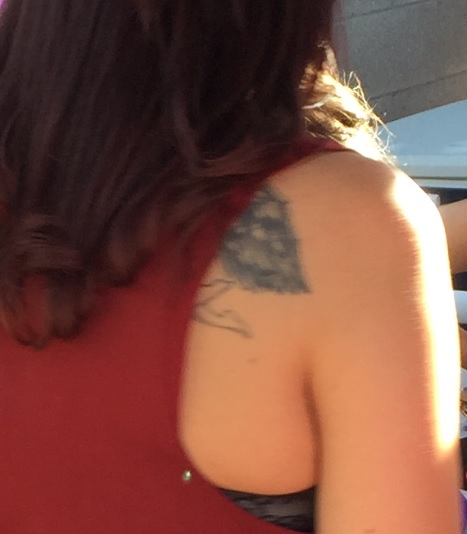Forces Behind Growing Demand for Tattoo Removal
Tattooing is a Growing Industry
There is no question that tattoos are becoming more popular especially among young adults.
Recent statistics indicate steady growth for the industry in terms of both increasing numbers of tattoo establishments as well as increasing revenue for the industry as a whole. Tattoo parlors, in addition to increasing in numbers, are also moving from back alleys in seedier parts of town to more respectable commercial areas.
A 2012 post (In Tattoo Business, Profits are Hardly Skin Deep) on the NBC News website reported that as of 2010, the 15,000 and growing number of tattoo parlors were producing total industry revenues in excess of $2.3 billion dollars per year.
At the same time the number of people getting one or more tattoos is also increasing. A January 2012 Harris Poll found that 21% of the U.S. population had at least one tattoo and this percentage was an increase over their 2008 poll which showed only 16% of the population had a tattoo. And the 2008 poll results were higher than their 2003 poll which showed 14% of the population having at least one tattoo.
However, before rushing to invest in the industry or deciding to train to be a tattoo artist there are some additional statistics that cast a shadow on this industry’s future.
Effect of Potential Demographic and Cultural Changes on Tattoo Industry's Continued Growth Prospects
While people of all adult age groups are getting tattoos, the vast majority of people patronizing the tattoo industry are young adults in their late teens to early thirties. These are members of the so called Millennial or Generation Y generation. Millennials is the name given to children born roughly between 1980 and 2000 (depending upon the source the start and end dates for this population cohort vary some but these years are when the majority were born).
The majority of the approximately seventy-six million American children born into the post World War II Baby Boom generation (those born roughly between 1945 and 1964) initially delayed getting married and having children which resulted in a sharp drop in births from the mid-1960s to the the 1980s. When the Baby Boomers did decide to start having families beginning in the 1980s the result was a demographic cohort totaling as many as 80 million children (the Millennials) who have now reached adulthood.
This so called Millennial generation has come of age during the longest economic downturn since the Great Depression of the 1930s and, like their grandparents who came of age during the 1930s many have been forced to put off carers, marriage and starting families. Unlike their grandparents coming of age in the 1930s this group, on average, does have considerable disposable income for things like tattoos.
Tattoo on Back and Can Be Easily Covered

Tattoo Removal Business Encountering Record Growth
With this group starting to move into their thirties, job prospects beginning to improve as the economy improves and few children behind to fill the gap the Millennials are in the process of maturing and leaving the young adult portion of the population. Because of this the market for tattoos could be seeing declines in the near future.
While revenues in the tattoo industry continue to grow, numbers of customers and revenues are also growing in the Tattoo Removal industry.
A Jul 17, 2014 Wall Street Journal Online posting (Tattoo Removal Surges 440% Over the Last Decade) stated that the smaller and newer tattoo removal industry has been growing rapidly having increased 440% over the last decade. Revenues for the tattoo removal industry have totaled $75.5 million over the past ten years and are expected to reach $83.2 million over the next four years.
The Two Parts of the Tattoo Removal Industry
One segment of this industry produces and markets make up that can effectively cover up and hide tattoos. The advantages of this are that it is fast and relatively inexpensive compared to full tattoo removal option. With the makeup, individuals can cover tattoos when work or social engagements require no visible tattoos while allowing the wearer to display their tattoos on other occasions.
Makeup creams that cover tattoos can be purchased for $35 or less per container. Of course, since these hide, rather than remove, tattoos this is an ongoing expense.
The other option is full removal of the tattoo. This process is both painful and expensive. However, this option permanently removes the tattoo which can come in handy when one wants to remove a very visible name or picture of a former lover before starting a new relationship.
Costs tattoo removal vary widely depending upon the type of establishment (dermatologist practices tend to be more expensive than clinic specializing in tattoo removal), geographic location, tattoo color, location on body and skin type. In my research I have found prices ranging from $49 to $300 per square inch for laser tattoo removal.
These rates are per session and it often takes multiple laser sessions to remove a single square inch. Even at the low price of $49 per square inch, the price can quickly add up when you are paying for multiple visits for the same square inch. Removal of a full arm tattoo can result in thousands of dollars having to be spent.
A Full Arm Tattoo

Prospects for Tattoo Industry May be Dimming in Near Future
Demand for tattoos will probably decline but will never disappear. After all, tattooing has been practiced in societies worldwide since before recorded history. The practice has had its ups and downs but has always existed in some societies in some parts of the world throughout history.
However, in the United States in the coming years, the industry will find itself shrinking.
The first reason is demographic as the main market and driver of its growth is young adults. Currently this group in the U.S. is not only maturing but has as yet produced few children to replace their numbers in the young adult age group.
The second reason is fashion. One constant in the fashion industry is change. People’s tastes change and what is new and hot at one moment becomes old and common later.
Parents of today’s Millennials were the Baby Boomers which burst onto the scene as young adults in the late 1960s and were known for their outrageous fashion - shoulder length hair and ponytails on men, bell bottom pants, granny dresses, super short mini skirts, beads and beards to name a few.
While the style stood out and was popular to an extent with many, but not all Boomers, the sixties fashion began disappearing as that population cohort began to mature and take on the responsibilities of career, marriage and parenting. One only has to look at pictures of grandparents and other family members who were young adults in the late sixties and seventies to see the difference in fashion between then and now.
Like their parents turning away from the outrageous styles of the sixties, today’s Millennials will begin abandoning tattoos especially as they begin to move into careers and marriage. Reports from the tattoo removal industry indicate that careers and marriage are major factors motivating their clients in seeking tattoo removal.
The military has tightened its policy on tattoos and, as I indicated in my previous Hub dealing with tattoos and job interviews visible tattoos adversely affect one’s chances of obtaining a job in many industries.
Tattoo Removal Appears to be More Popular Among Women Rather than Men
Current statistics indicate that most people seeking to have tattoos removed are in their thirties and forties. The reason usually given is that what was good at 20 is no longer desirable at 40.
Since the age at which many of today’s Millennials are discarding their tattoos is similar to the age at which many of their parents began discarding the fashions of the sixties we can probably expect the tattoo removal business to continue growing .
However, having a tattoo removed is more expensive and painful than getting a haircut or discarding some out of style clothing. This cost and pain factor may reduce somewhat the demand for full tattoo removal while at the same time increasing the demand for makeup to cover up tattoos.
Tattoo removal also seems to be more popular among women than among men. The main evidence here comes from a 2006 research survey conducted by the Texas Tech Center for Health Sciences the results of which were reported in the July 2008 issue of the Archives of Dermatology.
Tattoo Removal in Action
Some preliminary research also suggests that lack of tattoos on a woman may make her desirable as a marriage partner. A May 20, 2013 post (How Do People View Women With Tattoos?) on the Psychology Today website reported that research in France suggested that men were attracted to women with tattoos for short term sexual affairs but preferred women without tattoos when considering marriage. The tentative conclusion was that many men tended to view a tattoo on a woman as a sign that she was sexually promiscuous.
Whether men seek women without tattoos for marriage is still open to question, but in interviews with owners and managers of tattoo removal centers these business people indicate that pending marriage is a common reason given by their women clientele for wanting to have their tattoos removed.
The summary of findings from the 2006 research survey cited above also indicated that, in addition to more women than men were seeking tattoo removal services, their reasons often dealt with feelings negative societal pressure and a change of heart over time regarding their tattoos. Some of this could be that these women were no longer satisfied with their tattoos as fashion. On the whole women tend to be more fashion conscious than men and change fashion more frequently than men.
Tattoo Industry’s Future Not Completely Bleak
Despite the growth of the tattoo removal industry and changing demographics and attitudes as the millennials mature, there are some bright spots on the horizon for the tattoo industry.
Surprisingly, a big reason is that the demand for tattoo removal has led to increased efforts by the tattoo removal industry to come up with newer, less painful and less expensive ways to permanently remove tattoos.
Also, advances in the science behind tattoo inks also promises the possibility of making inks that break down faster and easier when exposed to the lasers used in tattoo removal.
Cheaper and less painful tattoo removal may actually help to maintain demand for tattoos as when people know that they will be able to enjoy a tattoo and then remove discard it with ease more people will be tempted to indulge in being tattooed.
This makes tattoos more like other types of fashion than can be easily and inexpensively changed.
© 2015 Chuck Nugent



